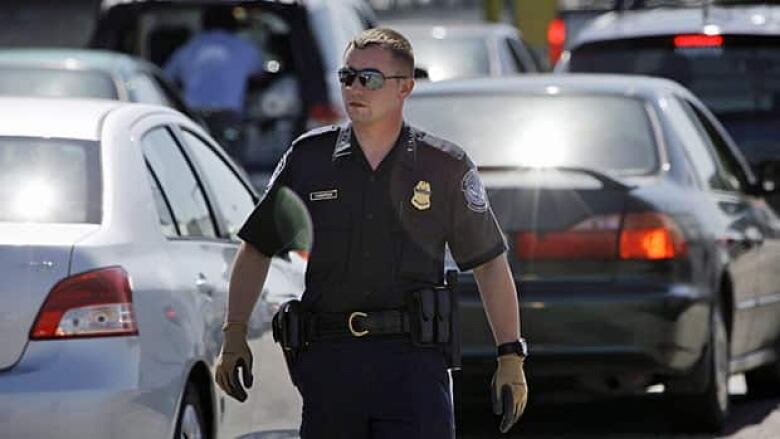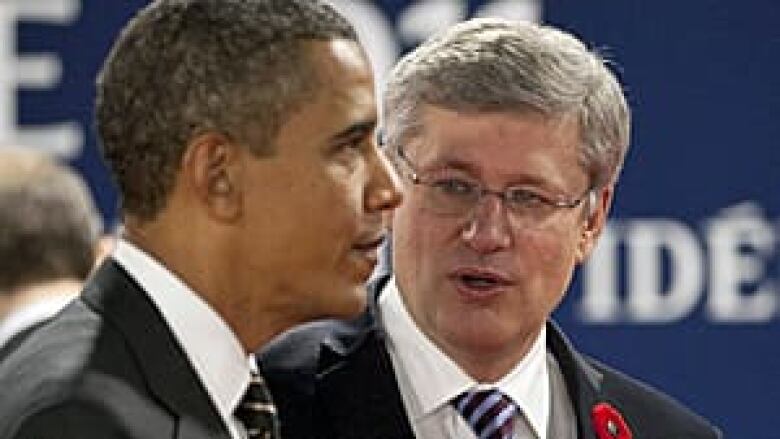Canada-U.S. border deal will track departing travellers

The federal government has lost track of more than 40,000 failed refugee claimants ordered deported from Canada up to 15 years ago, and who may still be wandering the streets illegally.
Similarly, at any given time, there are about 300,000 foreign workers, students and visitors in the country on temporary visas, but the government has no accurate way of knowing how many are here illegally after their permits expired.
In both cases, the problem is the same: Canada has no exit monitoring at the border.
While everyone arriving in Canada has to be checked, cleared and registered, travellers can drive across the border into the U.S. without telling anyone in this country that they are leaving.
Ditto for travellers leaving the U.S. and entering Canada the American border service generally has no record of their leaving that country.
The Canadian immigration department says that while there are currently outstanding deportation warrants for 40,815 failed refugee claimants who have been ordered kicked out of the country, no one really knows how many have already left on their own.
One senior immigration official describes the situation as "massive and not getting any better."
That should change in the near future.
Exit controlsa key feature
CBC News has learned a new system of exit controls is the key feature of a proposed Canada-U.S. border deal intended to make trade and travel easier between the two countries.
The much-touted and long-awaited border deal will be unveiled in Washington on Wednesday afternoon when Prime Minister Stephen Harper meets with U.S. President Barack Obama.
The deal is actually an action plan to reach agreement on three dozen proposed new measures intended to ease congestion of trade and travellers at the border without compromising security.
Those include:
- $1 billion of infrastructure projects over five years to upgrade crossings and move customs clearing areas away from international bridges to ease traffic congestion.
- Expansion of the so-called trusted traveller and trade programs that provide express lanes across the border for pre-screened frequent travellers, and pre-inspected goods cleared where they are manufactured and shipped in sealed containers.
- A new program called "screened once, accepted twice," that would allow shipments entering Canada from abroad to be cleared to American standards by Canadian customs and vice versaand then shipped across the border without being cleared again.
- A broad range of regulatory changes to harmonize Canadian and American commercial standards on everything from cars to breakfast cereals.
While any plan to integrate trade and security between the two countries is bound to spark debate over whether Canada is selling out to Uncle Sam, the most controversial move is likely to be the proposed exit controls and sharing of Canadian traveller information with U.S. security authorities.
For the first time, travellers to the U.S. would have their departure from this country recorded with Canadian border authorities.
Canadian government sources say they expect ultimately to be collecting exit information on everyone leaving Canada to all foreign destinations by land, air or sea.

While exit monitoring should go a long way to solving the apparent disappearance of failed refugees and temporary migrants, most Canadians probably won't notice the difference.
Canadians travelling across the border by car, train, bus, or on foot would continue to clear only U.S. customs and immigration.
The only difference under the proposed border deal is the information collected by U.S. officials from travellers leaving Canada would be shared with Canadian customs.
The same would apply to travellers entering Canada from the U.S. Canadian customs would collect the information and automatically pass it along to their American counterparts as exit data.
Information on all airline passengers flying to or even over the U.S. is already shared with American security authorities.
How much info will be shared?
The most contentious issues will be how much information on Canadians is going to be shared with the Americans once the two countries' computer systems are linked, how will it be protected from abuse, and what happens to travellers wrongly accused of being a security threat.
Canadian and American border officials have long talked about vastly expanding the use of biometric identification at the border, and standards for doing that are expected to be part of this week's border deal.
Canada's privacy watchdog has already raised some stern warnings about the so-called perimeter border deal.
Privacy Commissioner of CanadaJennifer Stoddard recently said Canada should not agree to exchange information on Canadians with American border authorities without extensive safeguards against abuse.
"Any mistake can have grave consequences, including stranding travellers at airports or branding them as terrorists," she said.












_(720p).jpg)


 OFFICIAL HD MUSIC VIDEO.jpg)
.jpg)



























































































